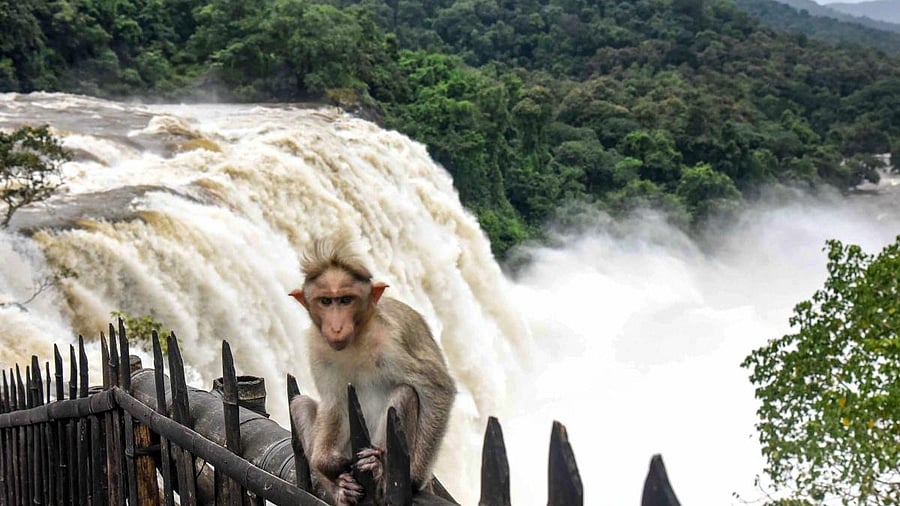
A monkey sits in the backdrop of a heavy gush of water following heavy monsoon rainfall, at Athirappilly waterfall in Thrissur
Credit: PTI photo
In what can only be described as a dazzling feat of bureaucratic imagination, the Kerala State Electricity Board (KSEB) has resurrected its favourite zombie, the Athirappilly dam project, this time dressed up in a jaunty little ecotourism hat. Because nothing screams ‘eco-friendly getaway’ like spending your weekend perched above a concrete wall that would drown forests, displace tribes, and choke one of Kerala’s last free-flowing rivers!
The Athirappilly Hydro Electric Project (AHEP) in Kerala, initially proposed by the KSEB in 1979 to generate 163 MW from the Chalakudy River, has faced a long history of environmental, social, and legal challenges.
The proposed dam will affect 138 hectares of forestland and the livelihoods of Kader and other tribal families who depend on the forest and river, submerge a stretch of 28.5 hectares of riparian forest, and reduce or dry up the water flow of the Athirappilly waterfall, which is crucial for preserving the ecology.
After being scrapped in the 1980s due to environmental and technical concerns, the project was revived in 1998, but it met opposition from environmentalists, tribal communities, and tourism stakeholders worried about the impact on the Athirappilly waterfalls and biodiversity. Surprisingly, the project was granted environmental clearance in 2005, but renewed protests and expert criticism of the Environmental Impact Assessment (EIA) led to the Kerala High Court cancelling the clearance in 2007.
Subsequent attempts to revise the project and secure fresh clearances faced continued criticism for threatening the river ecosystem, endemic species, tribal livelihoods, and the tourism economy. The Forest Advisory Committee rejected forest clearance in 2015, and renewed opposition persisted when the project was once again given a fresh lease of life in 2018 under the state government, citing energy needs, but, faced strong resistance over potential ecological damage and tribal rights violations.
From 2020 onwards, the project has been dormant in dusty files, without formal clearance, continuing to appear in state power plans but hindered by legal, ecological, and public opposition. However, in April, in an unexpected official order, KSEB proposed reviving the project by integrating hydropower generation with tourism development, aiming to maintain water flow to the waterfalls and enhance tourism amenities, including tribal welfare facilities. This approach seeks to address past concerns by ensuring water release to keep the falls alive year-round, and promoting tourism activities like boating and potential seaplane services.
According to Biju Prabhakar, Chairman, KSEB, the board was forced to revise the project as Kerala is dependent on other states to meet around 70 per cent of its power demands. Kerala currently faces an electricity shortfall of nearly 1,500 MW, with its internal capacity of around 3,819 MW falling short of a peak demand of 5,301 MW.
Bridging this gap does not require ecologically destructive projects like the Athirappilly dam. The state has immense potential to meet its deficit through smarter, decentralised options. For instance, with over 1300 MW already installed. Expanding rooftop and floating solar can provide reliable daytime power without land conflicts.
Additionally, investments in Battery Energy Storage Systems (BESS) can stabilise solar generation and ensure evening peak supply. Kerala plans to integrate 2 GW/4 GWh of BESS by 2030. Scaling up onshore and offshore wind projects, particularly in Palakkad and coastal districts, could add another 1,600 MW. Combined with grid modernisation and efficiency improvements that have already reduced transmission losses to 7.6%, these decentralised, climate-resilient options can bridge Kerala’s shortfall without drowning forests or tribal futures under yet another dam.
The 2018 floods in the Chalakudy River basin clearly exposed dam-related risks. Heavy rains and sudden water releases from Tamil Nadu’s Upper Sholayar Dam rapidly filled Kerala’s Lower Sholayar and Poringalkuthu dams. Poringalkuthu overtopped, causing the Chalakudy River to rise 16 feet, inundating two-storey houses in no time. This shows how upstream dam releases without co-ordination can cause catastrophic downstream flooding, stressing the need for integrated basin management and real-time communication to prevent disasters.
So far the Pinarayi Vijayan government has not greenlighted the KSEB’s latest move, but neither has it announced the final closure of the ill-fated proposal, considering that a spectrum of political parties, especially the Communist Party of India (CPI), the second largest constituent of the ruling alliance, the Congress, environmentalists, and the Kerala Sasthra Sahitya Parishad (KSSP), have reiterated their strong opposition to the project.
Their opposition to new dams in Kerala is best captured in the words of late Latha Ananth, who waged a lifelong campaign to protect the Chalakudy River, “Dams are not benign, nor do they last forever! The rivers in India are losing their irreplaceable ecological functions. ‘Flow regime’ is central to the maintenance of habitat heterogeneity and the diversity of river species. Dams are disturbing this most critical environmental aspect.”
Perhaps, the real reason the KSEB and successive Kerala governments keep reviving the Athirappilly dam project is that it is the perfect bureaucratic comfort blanket — a project that never has to generate a single watt of electricity, only endless megawatts of paperwork, committee sittings, feasibility studies, and career promotions.
(Shailendra Yashwant is a senior adviser to Climate Action Network South Asia) (CANSA). X: @shaibaba.
Disclaimer: The views expressed above are the author's own. They do not necessarily reflect the views of DH.